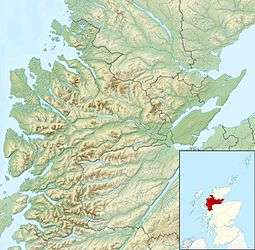Black Isle

The Black Isle (Scottish Gaelic: an t-Eilean Dubh, pronounced [ən̪ˠtʲelan d̪̊uh]) is a peninsula within Ross and Cromarty, in the Scottish Highlands.
It includes the towns of Cromarty and Fortrose, and such villages as Conon Bridge, Muir of Ord, Munlochy, Avoch, Rosemarkie, Tore, North Kessock, and Culbokie.
Description
Nov2007.jpg)
Despite its name, the Black Isle is not an island, but a peninsula, surrounded on three sides by water – the Cromarty Firth to the north, the Beauly Firth to the south, and the Moray Firth to the east. On its fourth, western side, its boundary is delineated by rivers. The River Conon divides Maryburgh, a mile outside Dingwall, from Conon Bridge which is the first village on the Black Isle from the north-western side. Its southwestern boundary is variously considered to be marked by either a minor tributary of the River Beauly separating Beauly (in Inverness-shire) and Muir of Ord (on the Black Isle in Ross and Cromarty), dividing the two counties and also delineating the start of the Black Isle; or alternatively, the River Beauly itself, thus including Beauly in the Black Isle despite its official placement in Inverness-shire.[1]
Castles
Castles on the Black Isle (whether ruinous or otherwise) include Castlecraig, Redcastle, and Kilcoy Castle. Cromarty House stands on the site of former Cromarty Castle and is built in part from its reclaimed stone and timbers. Kinkell Castle has been recently restored. Former castles of the Black Isle for which there are no physical remains include Castle Chanonry of Ross and a mound indicating the former site of Ormond Castle.
History
Conventional middle to modern Black Isle history is well documented at a number of visitor centres and cottage museums sprinkled across the peninsula. According to the Encyclopædia Britannica Eleventh Edition, it was originally called Ardmeanach (Gaelic ard, height; maniach, monk, from an old religious house on the wooded ridge of Mulbuie), and it derived its customary name from the fact that, since snow does not lie in winter, the promontory looks black while the surrounding country is white.
Rosehaugh, near Avoch, belonged to Sir George Mackenzie, founder of the Advocates' Library in Edinburgh, who earned the sobriquet of "Bloody" from his persecution of the Covenanters. Redcastle, on the shore, near Killearnan church, dates from 1179 and is said to have been the earliest inhabited house in the north of Scotland. On the forfeiture of the earldom of Ross it became a royal castle (being visited by Mary, Queen of Scots), and afterwards passed for a period into the hands of the Mackenzies of Gairloch.
The Black Isle was one of the earliest parts of the northern Highlands to experience the clearances and was settled with many Lowland shepherds and farmers, especially from the north east.
Education
The principal secondary school on the Black Isle is Fortrose Academy which currently has around 780 pupils.
Customs
In addition to its Gaelic heritage, the Black Isle had its own dialect of North Northern Scots, used mainly among fisherfolk in Cromarty, which became extinct in October 2012, upon the death of Bobby Hogg, the last native speaker.[2][3]
See also
References
- ↑ Black Isle Info Archived November 23, 2005, at the Wayback Machine.
- ↑ Satter, Raphael (4 October 2012). "Scottish man dies, taking town’s unique dialect with him". The Toronto Star. London. Retrieved 4 October 2012.
- ↑ Jamie Hamilton, for CNN (5 October 2012). "Last native speaker of Scots dialect dies - CNN.com". CNN. Retrieved 17 February 2015.
External links
 Media related to Black Isle at Wikimedia Commons
Media related to Black Isle at Wikimedia Commons- Black Isle Partnership website
- Listen to recordings of a speaker of Scots from the Black Isle
Coordinates: 57°35′27″N 4°14′30″W / 57.59083°N 4.24167°W